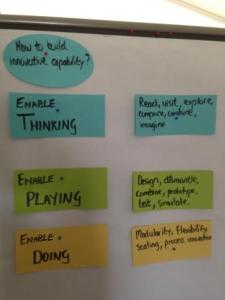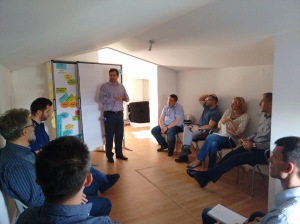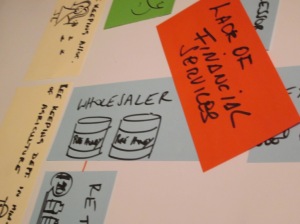The average manufacturer in a developing country grapples with the notion of innovation. That is why they are often called “traditional”, although almost each industry would have one or two outliers. While governments, like South Africa, offers incentives to stimulate innovation, most manufacturers do not identify with the term the way the governments use it. For instance, when governments use the word “innovation” they often mean “invention“, in other words something that can be protected, copyrighted and owned (more about the differences between innovation and invention here). While I understand the argument for patenting and protection I think this narrow definition of innovation is inhibiting many industries from increasing their productivity and competitiveness by copying what works from elsewhere (catching up). It also fails to recognize that in many value chains the manufacturers themselves make components or sub-systems that goes into overarching architectures (defined by standards, compliance, specifications), so their design authority is limited in scope.
Herewith a list of synonyms from thesaurus.com for innovation that I have assessed to see how enterprises might understand or respond to these words:
- Modernization – lots of enterprises dream about this but often do not have the many nor the organizational capability to pull it off (one day, next time)
- contraption – many innovations and most inventions result in one of these. You can see them standing in the corners in most factories
- Mutation, addition, alteration, modification – this is what most innovations in traditional industry would look like. They are doing this all the time as their machines gets older, but this behavior is mostly not recognized nor accelerated
- newness, departure, deviation – the bolder enterprises with more financial and organizational capability might try these, but it takes capital to maintain.
Most people understand innovation as an outcome, but the word itself is a noun that implies change and novelty. It is about a shift, even if it is often incremental. The reason why so many of our enterprises here in South Africa are not deemed to be innovative is because they struggle (or perhaps do not have the organizational capability) to manage several simultaneous change processes. As Tim Kastelle posted some years ago, change is simple but not easy. Although this is often described as a technology problem it is really a management problem (see some older posts here). I would go even further and state that in many industries the margins are so thin that even those enterprises that have a reasonable management structure would struggle to finance many innovations at the same time.
However, in my experience of visiting more than 50 manufacturers every year I am always stunned and awed by how ingenious these companies are. They keep old machines running, often modifying them on the fly. They operate with fluctuating and unreliable electricity, inconsistent water pressure and often hardly any specialist support. What policy makers often do not recognize is that in developing countries it takes a lot of management time and capacity just to keep the throughput going. The time and effort to go explore “change” beyond what is necessary in the short to medium term is very expensive. The costs of evaluation new ideas, new technologies, new markets and better suppliers are all far more expensive in developing countries than elsewhere. Yet, at the heart of innovation is the ability to combine different inputs, different knowledge pools, different supporting capabilities with different market possibilities.
There are two implications for innovation promotion practitioners.
- The process of instigating innovation must start with recognizing how companies are innovating NOW. How are they modifying their processes (and products), and how much does it cost? What are the risks that are keeping them from introducing more novelty? Perhaps use the Horizons of Innovation (my next post) to create a portfolio of innovation (change) activities that can be identified at the enterprise or industry levels.
- It is hard if not impossible for different manufacturers in most countries to figure out what others are struggling to change at a technological level. Use your ability to move between enterprises to identify opportunities to turn individual company costs into public costs (this is often cheaper). Do not take the innovation away from enterprises, but use your meso level technology institutions to try and accelerate the learning or to reduce the costs of trying various alternatives. Be very open with the results to enable learning and dissemination of ideas.
The process of instigating innovation must start with recognizing where manufacturers are naturally trying to change, just like a change process in an organization must start with understanding current behavior, culture and context. Somehow innovation have become so associated with a contraptions and narrow views on technology that the organizational development body of knowledge and management of change have been left behind.










